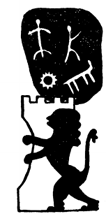Introduction
THE EXPANSION of Spain in the New World, like the expansion of other European nationsin the Americas, Africa, and Asia, is a series of events the record of which willremain forever incomplete. No amount of inference from the meager facts recordedcan ever establish the full nature of the events. It is not that there was any lackof European commentatorsthere were many. But the natives of the invaded regionswere not literate people, and therefore what they thought and said about what washappening to them was never adequately recorded. Especially in the earlier periods,there are no accounts by natives of their reactions to the contacts with the invaders.It is true that the words of some native leaders and occasionally even the commentsof some common man were set down, but the recording was done by Europeans and theaccounts thus bear the mark of European interpretation. Again and again, what purportsto be a record of the native viewpoint is actually what the European writers thoughtthe natives were thinking.
This situation prevails in the records of contacts in the region with which thisvolume is concerned. It was a rare Spanish chronicler who was equipped for the exactingtask of even moderately objective reporting. Although often sympathetic, Spanishaccounts have the inevitable bias of writers from one culture looking through thebarriers of language and cultural difference at the members of another. There isno way in which this bias can be corrected. Thus, it is when the question is raisedas to what Indians thought about Spaniards and Spanish culture that the great voidin the record appears. This void seriously impairs our understanding of these instancesof human development.
It is especially in the earliest phases of contact that the record is so one-sided.One searches in vain for records of the Indians first impressions of the Spaniardsto match the Spaniards first impressions of the Indians. As the contacts continued,some Spaniards learned something about the Indians, but even so they rarely recordedmuch more than descriptions of externals such as clothing and the reactions to Spanishbehavior which were usually mistaken for normal Indian behavior. Fortunately, however,some Indians appeared in court either to testify against some missionary on chargesof mistreatment of Indians, to answer for themselves on charges of insubordinationor Insurrection, to testify against some civil governor on charges brought againsthim by the missionaries, or on some other account. Insofar as the northwest of NewSpain is concerned, it is almost entirely in such court records that the authenticvoices of the Indians are heard. However, this setting is so alien, so framed interms of Spanish culture, that often too little that is revealing emerges. Indeed,until well into the nineteenth century the records are nearly mute on the subjectof Indian viewpoints and feelings about the transformation being wrought in theirlives.
The names of a few distinguished Indians were recorded, and occasionally a writerattempted a sympathetic appraisal such as Andrs Prez de Ribas remarkable sketchof the Opata leader Sisibotari. But for the most part there is really no historyof the Indians, only the history of the Spaniards in their contacts with the Indians.Through a glass darkly, something and probably the main outline of what was takingplace can be discerned. However, insofar as the Indians are concerned, it is historywithout letters written by the principals, without a single state document, withoutdiaries, notebooks, newspapers, or memorandums! Only the last hundred years of ourepoch can be regarded as providing records for Indian life in any way comparableto those for the history of the invaders.
There is little that can be done to correct the lens, but at least it can be keptin mind that there is a distortion. Nothing brings the fact home more definitelythan to remember that none of the major tribes enters or maintains a place in historyunder its own name. The names used are misnomers of one sort or another bestowedby Spaniard or Anglo-American. Even the villages of the Pueblo Indians, where onemight have expected the invaders to adopt the native place names, were renamed or,with one or two exceptions, inaccurately recorded.
It is in full recognition of the fact that the information about the Indians themselvesis secondhand and terribly biased that the exposition of the history of the contactsof the Indians of northwestern New Spain with the Spaniards is undertaken in thepages which follow.
The history of Indian-Spanish contacts presented here opens in the last decade ofthe 1500s. Sixty years have elapsed since Coronados journty of exploration andhis harsh subjection of the Indians on the Rio Grande River. In the intervening timethe explorations of Francisco de Ibarra and many others made it clear both that therewere enough Indians in the northwest to make it worthwhile for the missionariesto go among them and also that there was enough silver (if nothing much else in theway of natural resources) to make it worth the while of some adventurers and non-ecclesiasticalpersons. From Zacatecas, since the discovery of silver there in 1546, missionariesand miners moved out and settled in the Indian country. From Compostela and Culiacn,missionaries and soldiers moved slowly up the west coast, establishing presidiosand missions as they progressed from tribe to tribe. The Jesuit order of missionariesarrived in Mexico in the 1570s and began to carve out for itself the region of northwesternNew Spain as its special field of mission work. In twenty-five years Jesuits becamewell established among Indians of the southern Sierra Madre Mountains as far northas the border of the present state of Chihuahua. This region was christened New Biscay,the northernmost province of Spain in the New World. A whole line of silver lodeswas discovered on the eastern side of the Sierra Madres, extending from Zacatecasthrough a dozen smaller mines to Durango and finally to Santa Barbara.
Tribal Name
| as known in historical writing | as used by members of tribe |
| TARAHUMARA | RARMURI |
| MAYO | YOREME |
| YAQUI | YOEME |
| OPATA | TEWIMA, HEVE |
| SERI | KUNKAAK |
| PIMA | O-OTAM |
| PAPAGO | TOHONO O-OTAM |
| NAVAJO | DINH |
| APACHE | NDE |
| ZUNI | SHIWI |
| MOQUI, HOPI | HOPITUH |
| HAVASUPAI | PAI |
| HUALAPAI | PAI |
| YAVAPAI | YAWEPE, TOLKEPAYA |
| MARICOPA | PIPAI |
| MOHAVE | HAMAKAVA |
| YUMA | KWATSHAN |
| PUEBLOS | (No corresponding general term) |
Pueblo Village Name |
| TAOS | TEOTHO |
| PICURIS | PICURIA |
| SANDIA | NAFIAT |
| ISLETA | TUEI |
| SAN JUAN | OKEH |
| SANTA CLARA | XAPOGEH |
| SAN ILDEFONSO | POXWOGEH |
| NAMB | NAMBEE |
| TESUQUE | TETSUGEH |
| JEMEZ | WALATOWA |











